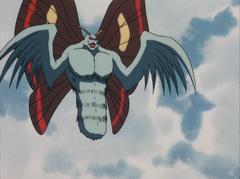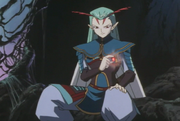See also: Yōkai moth

Gatenmaru, a notable moth yōkai.
Moth yōkai (蛾妖怪, "Ga yōkai") were anthropomorphic demons which share certain characteristics with moths.
Abilities[]

Moth yōkai, like many other types of yōkai, can take on humanoid forms to conceal themselves among humans, but even in this form they still posses great strength. They can also create silk with acidic properties which can inflict great burns on both humans and hanyōs, with this silk they can also make large cocoons in which to trap their opponents and give them a slow and painful death. When in their true moth form, they can fly and create powerful blasts of wind and even whirlwinds. Moth daiyōkai have shown greater abilities, such as creating energy beams, summon demons, powerful breath, control over yōkai moths and even being able to absorb countless souls at once.
History[]
200 years ago, a clan of moth yōkai from the Asian continent, led by their lord Hyōga, followed in the wake of the Mongol army of the Yuan dynasty during its invasion of Japan, in order to capture the souls of those slain in battle. However, they were defeated by the ruler of the western lands, the great dog daiyōkai Tōga, who sealed Hyōga and his son Menōmaru within the Tree of Ages in the Forest of No Return. However 200 years later, Menōmaru would escape and seek to reclaim his father's powers and conquer the world as he gets wings to summon his father's armies from the Ming dynasty, and nearly succeeded, but was narrowly defeated by the son of Tōga, the hanyō Inuyasha with the Backlash Wave along with Kagome's Sacred Arrow.
Notable moth yōkai[]
Trivia[]
Moth yokais are based on Shinchu in Japanese folklore great insect gods which resemble silkworm moths larger than elephants. The have saucer-like eyes, a gaping mouth full of sharp teeth, eight legs, enormous wings, and a long stinger protruding from the rear of their segmented abdomen. While they have a ferocious appearance, shinchū do not attack humans. Instead, they feed on demons and evil spirits. In particular, they prey upon yōkai which cause disease and spread epidemics. They rip their victims apart violently as they feed, leaving pools of blood and body parts in their wake. Their appetites are as big as the shinchū themselves. Every morning, a shinchū will consume three thousand demons, and every evening it will devour three thousand more.
References[]
| ||||||||||||
